Disclosure: My dog blog is supported by dog parents just like you. I only recommend products that I would use on my dogs. All opinions expressed here are my own. I sometimes earn a small affiliate commission, at no extra cost to you, when you click through the affiliate link and purchase something. You can read more about my affiliate policy here.
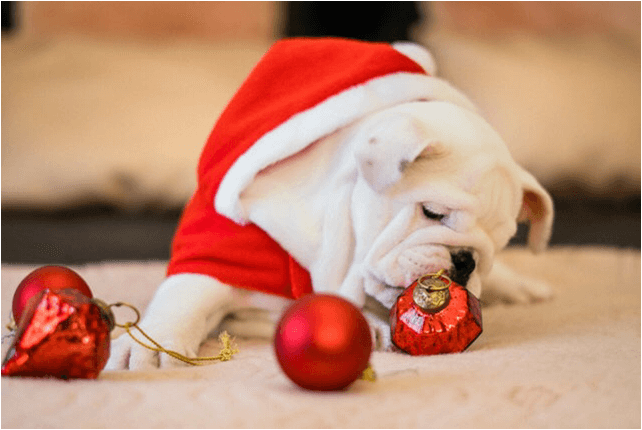
If your family received a new puppy as a Christmas gift this year, you are not alone. You are in for the best bonding experience the world has to offer. Your new companion will be your best friend, your soul mate; basically, your whole world. There is nothing better than the journey you have embarked on. However, adding a dog to your family is a big responsibility and a life-long commitment. Firstly, you will want to plunge into puppy socialization.
What Does Puppy Socialization Mean?
Puppy socialization is a process in which you need to go about introducing your puppy to the world. Most importantly, introduce your puppy to your world. This process helps puppies to be confident and unafraid of anything encountered throughout day to day life. That is to say, your puppy needs to meet people, go places, and do engaging things.
Think of how you want your puppy to react to the world as an adult. The goal of socialization is to get your puppy accustomed to and comfortable with the world around him. After all, your ultimate goal should be to have a happy, well-behaved adult dog. In order to achieve this, puppy socialization is the most important thing you can do for your puppy.
When to Start Socializing
It is definitely a time-sensitive process. It’s easier to create positive experiences with people and situations during the puppy stage than the adult stage. Furthermore, it is way more beneficial.
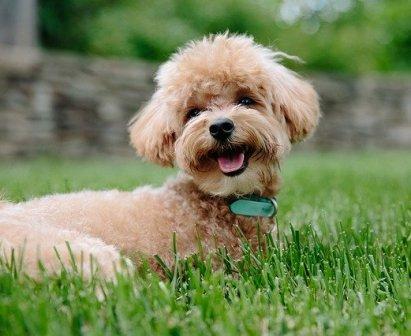
According to the American Veterinary Society of Animal Behavior, primarily puppy socialization is the first 3-months of life. They say during this time, puppies should be exposed to as many new people, animals, stimuli and environments. In addition, this should be achieved safely. This will help, without causing over-stimulation manifested as excessive fear, withdrawal or avoidance behavior.
This 3-month window is the best opportunity for your puppy to adapt to new people, animals, and experiences. The reason for this is because sociability outweighs fear. Puppies not receiving the proper and complete socialization needed during this window are at risk of behavioral problems. For example, they could experience fear, avoidance, and/or aggression during adulthood.
Be sure to pair treats with all exposures to make positive associations. However, don’t push your puppy if he seems frightened and won’t take the treats. Meanwhile, give him some distance from the situation until he is comfortable.
Where to Start Puppy Socialization
Firstly, start in your home. It is important for you to spend a lot of time with your puppy. But, it is also important that you encourage him to play on his own. Part of socializing your puppy is fostering independence, so he isn’t anxious when left alone.

Puppies should be encouraged to explore, investigate, and manipulate their environments. Your home has many items that will provide new experiences for your puppy. However, experiencing new things will sometimes be frightening for your puppy. So, being at home to face the fears will prepare your puppy to socialize out of the home.
Your puppy might be scared of the sound your blow dryer makes while you are drying your hair. If you notice this, then let your puppy explore the blow dryer while you aren’t using it. Then, when your puppy is in sight, but not near it, turn the blow dryer on. This is so he or she can see how it functions. Furthermore, address your puppy’s fears in a safe manner, so he doesn’t harbor anxiety about new experiences.
A Few Ideas for In-Home Socialization
- other dogs in the house barking
- television on
- garage door opening
- a doorbell ringing
- knocking at door
- phone ringing
- appliances turning on
- vacuum running
- water running in a shower
- taking a bath
- carpet
- shiny floors
- babies crying
- kids yelling
- knock at the door
- toilet flushing
Your puppy needs to be acclimated in your home with people and other pets, before having guests over. In addition, your puppy needs to be taught how to behave when guests arrive. For example, not to jump on guests or bark as they come through the door. Above all, only allow well-mannered behaviors with guests.
Socializing Outside of the Home
Why expose your puppy to new environments outside of your home? Mainly to learn to not be fearful in crowds or aggressive when approached by humans or other animals. You will want to introduce your puppy to a variety of people, young and old. You can do this indirectly by walking your puppy near a park where children are playing. Or, near a senior care facility where people are moving in wheelchairs or using walkers. This will help to feel at ease in both quiet and busy places later as an adult dog.
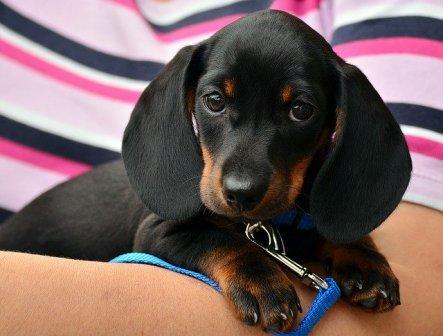
Your puppy will need to be taught the appropriate way to greet new people once he’s ready. Behavior specialists suggest making sure a puppy is calm and sits before allowing a person to greet him. Furthermore, make sure he isn’t confined when meeting new people. Do not let people rush to your puppy making him feel threatened. Likewise, make sure to not let them get in his face. Remember to take treats with you to reinforce good behavior.
A Few Ideas for Community Socialization
- your car
- the veterinarian’s office
- parks
- beaches
- shopping areas
- sidewalks with cars going by
- areas where you might walk or hike or vacation
- other people’s houses
- pet stores
- heavy rain
- boats
- tall buildings
- bicycles
- skateboards
- running kids
- kites
- motorcycles
- cars
- trucks
- fire engines
- running animals
- neighbors in their yards
- wind and thunder noises
- fireworks
- grass
- gravel
- pavement
- sand
- wet surfaces outside
Your puppy should never be forced into an interaction or situation he isn’t comfortable with. Make sure when you are socializing outside of the home to always foster a calm and safe environment.
Touching as Part of Socialization
Your puppy should be exposed to handling and touching in a pleasant way. For instance, holding and rubbing their paws will help later when it is time for a nail trim. Your veterinarian and groomer will appreciate you for having your puppy comfortable with his face and ears being touched.
There are many people out there who do not recommend hugging a dog. That can be for another post, but at some point in your dog’s life he is going to be hugged. So, you might as well expose him or her to hugs as a puppy.
Go ahead and expose your puppy to invasive interactions. For example, when someone invades his space, or takes things from him, or gets into his food. This invasive interaction will teach him to be comfortable when it happens. When exposing him to invasive interactions, you want to reward him for non-aggressive reactions. Even though this may seem mean to do, you are doing it for his protection and your own. Furthermore, it can protect a small child, or even another dog. At some point in his life, your dog may eat something he shouldn’t. So, if this happens, you need to be able to take it from him.
In Conclusion
Above all, make sure you and your puppy are having fun with socializing. Don’t expose him to everything at once, and don’t be forceful, or make it overwhelming. Also, remember to have treats available for when your puppy responds correctly. We have some great treat recipes in the Dog Chef section of our blog. Here are a couple to browse:
Do you have any puppy socialization tips for us? We would love to hear about them in the comments below.
You can use one of the following images to pin to Pinterest.
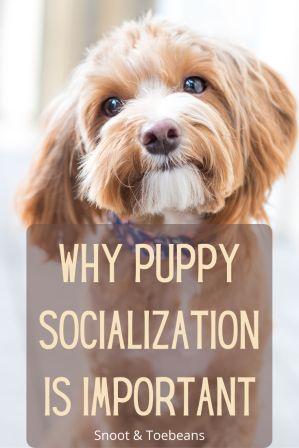
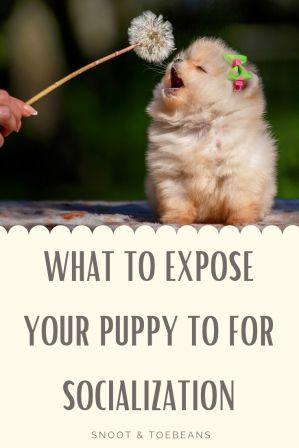
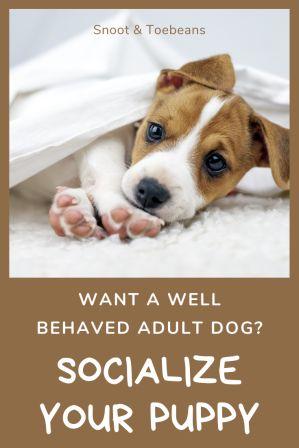
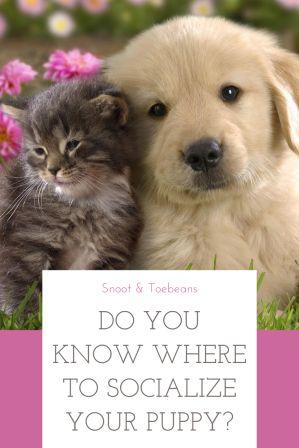



Pingback: Doorbell Training My Dog - Calming the Crazy | Snoot and Toebeans
Pingback: Your Older Dog Can Adjust to a Puppy | Snoot and Toebeans
Pingback: Adding a Puppy to Your Family - 6 Tips to Help Your Established Dog Adjust | Snoot and Toebeans